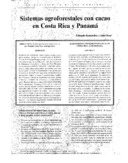| dc.contributor.author | Somarriba, Eduardo | es_ES |
| dc.contributor.author | Beer, John | es_ES |
| dc.contributor.other | CATIE – Centro Agronómico Tropical de Investigación y Enseñanza | |
| dc.date.accessioned | 2015-03-19T22:09:45Z | |
| dc.date.available | 2015-03-19T22:09:45Z | |
| dc.date.issued | 1999 | |
| dc.identifier | 474853 | es_ES |
| dc.identifier.issn | 1022-7482 | es_ES |
| dc.identifier.uri | https://repositorio.catie.ac.cr/handle/11554/6816 | |
| dc.description.abstract | Se presenta una síntesis de lo que se conoce. lo que se cree que se conoce y lo que no se conoce después de más de 10 años de investigación agroforestal con cacao en la estación experimental del CATIE y en fincas de agricultores de Talamanca (Costa Rica) y Bocas del Toro (Panamá). Las tecnologías estudiadas incluyeron: 1) especies leguminosas o maderables como sombra para plantaciones nuevas de cacao 2) especies leguminosas o maderables para la sustitución de sombra no reguladora e improductiva en plantaciones "viejas" de cacao 3) productividad. estabilidad y riesgo en sistemas diversificados con cacao, plátano y madera: 4) estudios de la biomasa y de los ciclos de agua y de nutrientes en cacaotales con sombra de maderables o leguminosas. El manejo diferencial por especie de sombra permite obtener similares rendimientos de cacao. No se detectaron diferenciales en la infestación por patógenos bajo diferentes especies de sombra. Los resultados financieros favorecen el uso de maderables como sombra: se recomienda utilizar cultivos de ciclo corto en los primeros años de las plantaciones para mejorar el desempeño financiero. Las especies leguminosas mejoran sustancialmente la materia orgánica del suelo. | es_ES |
| dc.description.abstract | A synthesis is presented of what we know, what we believe that we know, and what we still do not know after more than ten years of agroforestry research with cacao on the CATIE experimental station and on the farms of cacao producers in Talamanca, Costa Rica and Bocas de Toro, Panama. The technologies which have been studied include 1) legume or timber species as shade for newly established cacao plantations, 2) legume or timber species which can be substituted for ineffective or unproductive shade trees in "old" cacao plantations, 3) productivity, stability, and risk in diversified systems with cacao, plantain, and timber trees and 4) studies of the biomass production and hydrologic and nutrient cycles in cacao plantations with shade of timber or leguminous trees. The differential management of differen shade species permits obtaining similar cacao yields. No differences in the incidence of pathogens was found under different shade species. The results of financial analyses favored the use of timber trees for shade the use of species with a short cycle is recommended in the early years of plantations in order to improve financial performance. Leguminous shade species substantially improve soil organic matter levels. | en_US |
| dc.language.iso | es | es_ES |
| dc.publisher | CATIE, Turrialba (Costa Rica) | es_ES |
| dc.relation.ispartof | Agroforestería en las Américas Volumen 6, número 22 (1999), páginas 7-11 | |
| dc.rights | info:eu-repo/semantics/openAccess | es_ES |
| dc.subject | THEOBROMA CACAO | es_ES |
| dc.subject | AGROFORESTERIA | es_Es |
| dc.subject | ARBOLES MADERABLES | es_Es |
| dc.subject | LEGUMINOSAS FORRAJERAS | es_Es |
| dc.subject | PLANTAS DE SOMBRA | es_Es |
| dc.subject | PRODUCTIVIDAD | es_Es |
| dc.subject | DIVERSIFICACION | es_Es |
| dc.subject | BIOMASA | es_Es |
| dc.subject | BIODIVERSIDAD | es_Es |
| dc.subject | SOSTENIBILIDAD | es_Es |
| dc.subject | COSTA RICA | es_Es |
| dc.subject | PANAMA | es_Es |
| dc.title | Sistemas agroforestales con cacao en Costa Rica y Panamá | es_ES |
| dc.title.alternative | Agroforestry systems with cocoa in Costa Rica and Panama | en_US |
| dc.type | Artículo | es_ES |


